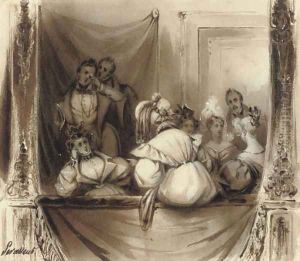Henri-Louis Levasseur Paintings
Henri-Louis Levasseur was a French sculptor born in 1853 in Paris. Coming from a family with an artistic background, Levasseur was exposed to the world of art from an early age. He pursued his education in the fine arts and honed his skills as a sculptor, which would later define his career and legacy.
Levasseur was known for his classical and allegorical figures, as well as his portrayal of historical and mythological subjects. He studied at the École des Beaux-Arts in Paris under the tutelage of eminent sculptors such as Cavelier, Millet, and Dumont. His artistic talent was recognized early on when he won the prestigious Prix de Rome in 1881, which allowed him to study in Rome, a center of classical art and culture.
On his return to France, Levasseur's works were met with acclaim. He regularly exhibited his sculptures at the Salon, the official art exhibition of the Académie des Beaux-Arts in Paris. His compositions were often marked by a sense of movement and a fine attention to detail, capturing both the physical beauty and the emotional expression of his subjects. Levasseur's artistic style was characteristic of the academic tradition, yet his work also reflected a personal interpretation that resonated with the public and critics alike.
Throughout his career, Levasseur received numerous awards and honors. His sculptures were sought after by collectors and were also commissioned for public monuments and memorials, reflecting the social and political milieu of his time. Despite the popularity of new artistic movements towards the end of the 19th century and the beginning of the 20th century, Levasseur remained committed to the classical aesthetic.
Henri-Louis Levasseur's death in 1934 marked the end of a long and productive career. His legacy is preserved in the form of his sculptures, many of which are housed in museums and public spaces across France. His work continues to be studied and admired for its craftsmanship and contribution to the canon of French sculpture.



